
What is biang biang noodle?
Biang Biang noodles (also called Yu Po Mian, 油泼面) are a type of Chinese noodle originating from Shaanxi province. The word “biang” is an onomatopoeia – it mimics the sound made in the process of making the noodles, when the dough is pulled and slapped against the working surface.
Known for their length and thickness, these noodles are hand-pulled, creating a chewy texture. They are served in a spicy, tangy sauce made with chili oil, soy sauce, vinegar, ginger, garlic and Sichuan peppercorns. The dish is known for its bold flavors and distinctive preparation method by pouring hot oil into the spices (literally translated to Yu Po, or pouring hot oil).
The character for “biang” is also famously complex, with many strokes, making it one of the most intricate Chinese characters.
If you try this dish even once, you will see that its popularity comes from its simplicity and deep flavor, and it stands out as a wonderful example of what I share in my Authentic Chinese noodle recipes roundup.
Why this recipe
I had the best bowl of Biang Biang noodles when I was visiting Xi’an (the city of origin for this dish) with my husband Thomas. It wasn’t even a famous restaurant, just a random small shop that we came across on the side of the road. The big bowl of fat noodles was topped with a savory tomato sauce, and a complex and well balanced chili sauce. It was so simple, yet also rich and satisfying.
When trying to recreate the Xi’an version of these noodles at home, I tried several methods and finally found a perfect one. My recipe uses:
- Well balanced savory sauces with soy sauce, vinegar, and sesame oil for the base.
- Chili flakes with other hidden flavors such as Sichuan peppercorns and cumin powder for a more complex chili oil.
- A simple two-ingredient tomato sauce to further enhance the taste and texture, rounding out the spiciness of the chili oil.
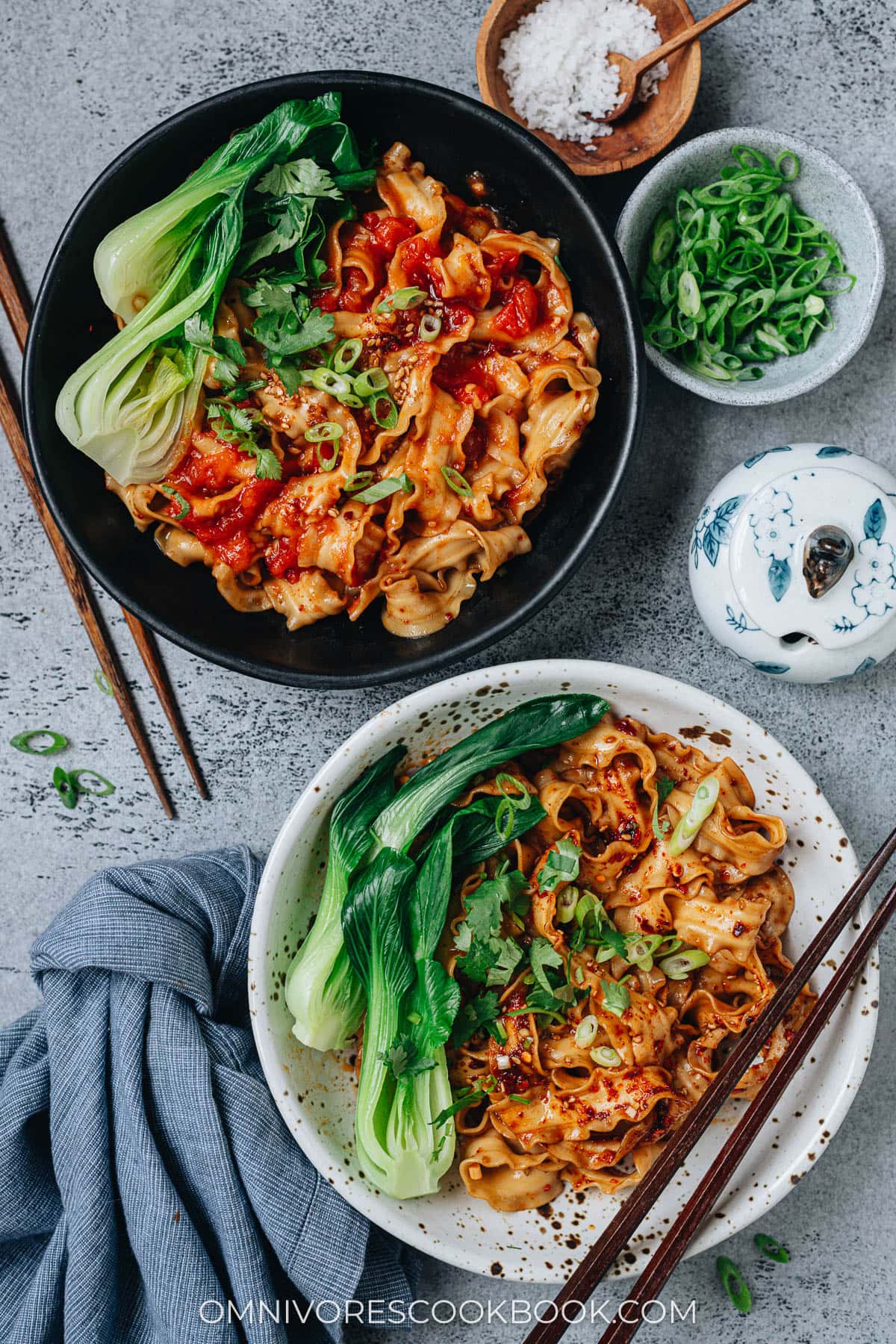
Ingredients for biang biang noodles
What type of noodles to use
Noodles are one of the most important components of the dish. For the best result, I highly recommend making your own hand-pulled noodles (the extra wide type in my recipe). It yields chewy noodles with the best texture.
The next best option is semi-fresh noodles that have a wide shape. The Havista brand Shan Xi Pull Noodles and Shanxi Planed Noodles are both great options. For these noodles, you can often find them in the refrigerated section of Chinese grocery stores or large Asian markets such as H-Mart.
In my recipe, I used the Dried Wide Knife Cut Noodles from The Mala Market. You can purchase them online and they stay in your pantry much longer.
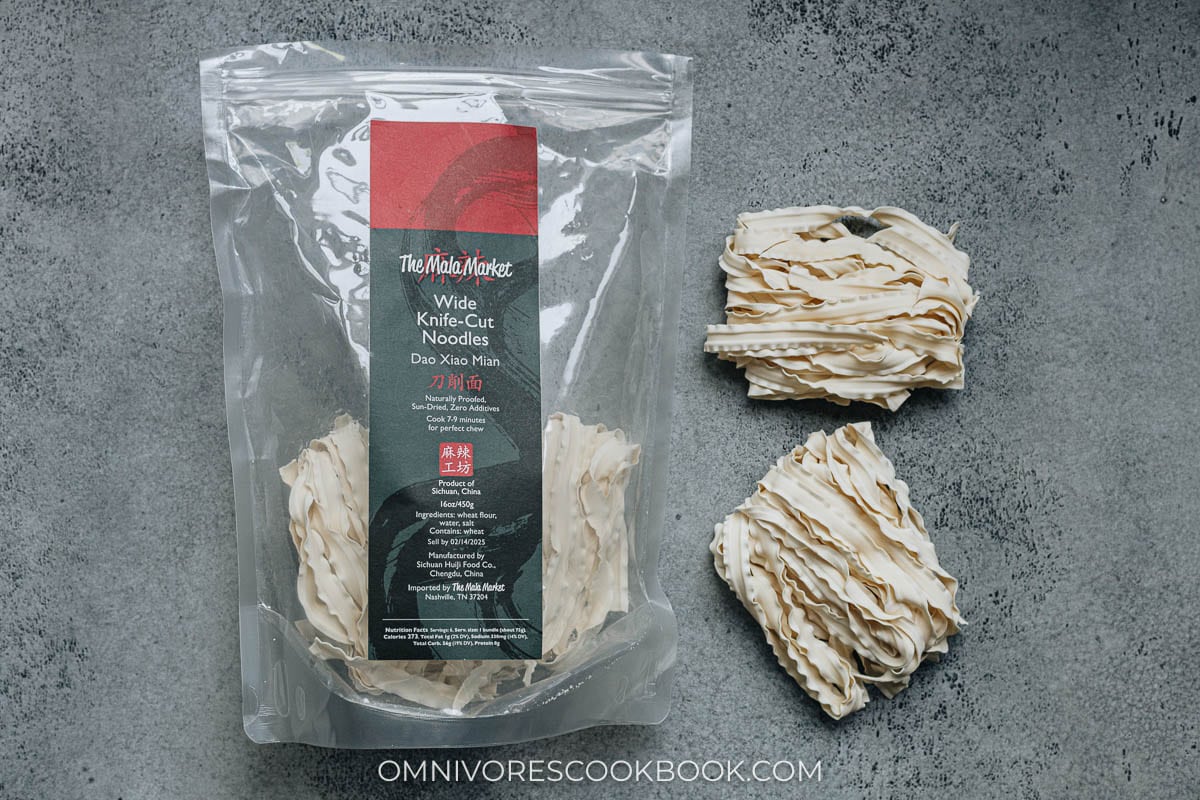
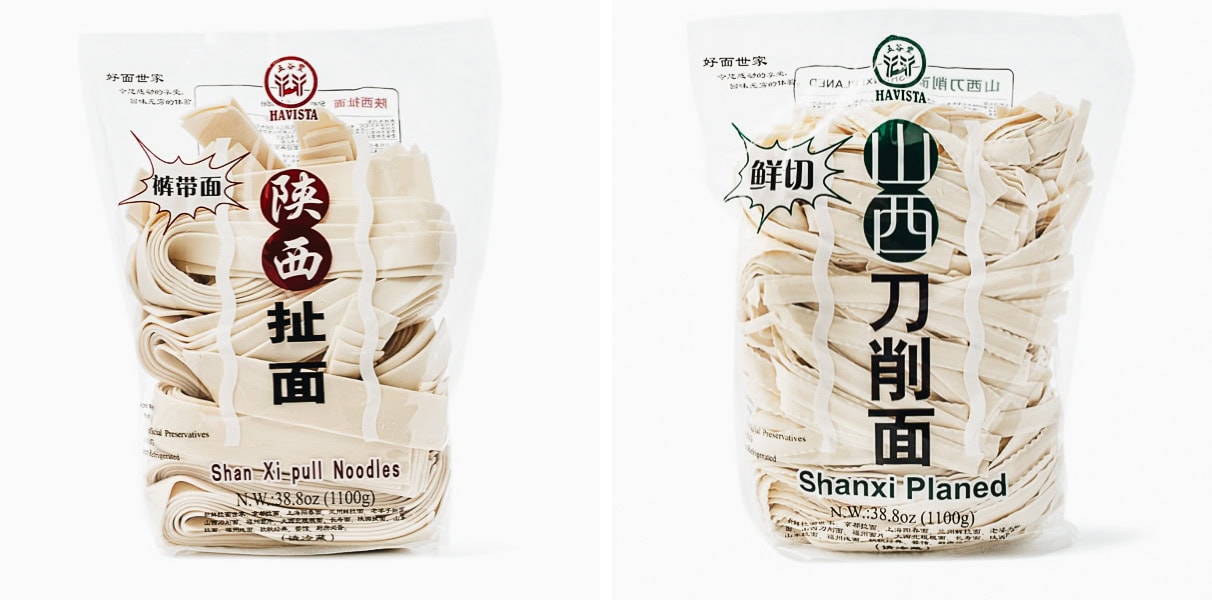
Chinese chili flakes (辣椒面)
Chili flakes are another important ingredient. To prepare biang biang noodles, you will be pouring hot oil over the chili flakes and other spices to make a chili oil. And chili flakes are the main ingredient for a great tasting sauce. The Chinese chili flakes used in this recipe are a coarse ground blend with a few types of Chinese chili peppers, ranging from smoky peppers to spicy peppers. The chili oil made with these chili flakes is moderately spicy and very fragrant, with a beautiful bright red color.
I highly recommend the chili flakes from The Mala Market, because they source the freshest spices directly from Sichuan, China.
Other seasonings
Chinese soy sauce (both the light and the dark type) and Chinkiang vinegar make the base of the biang biang noodle sauce.
I also used Sichuan peppercorns and cumin powder as hidden ingredients.
Fresh ginger, garlic and green onion, plus sesame oil add extra aroma and umami to the dish.
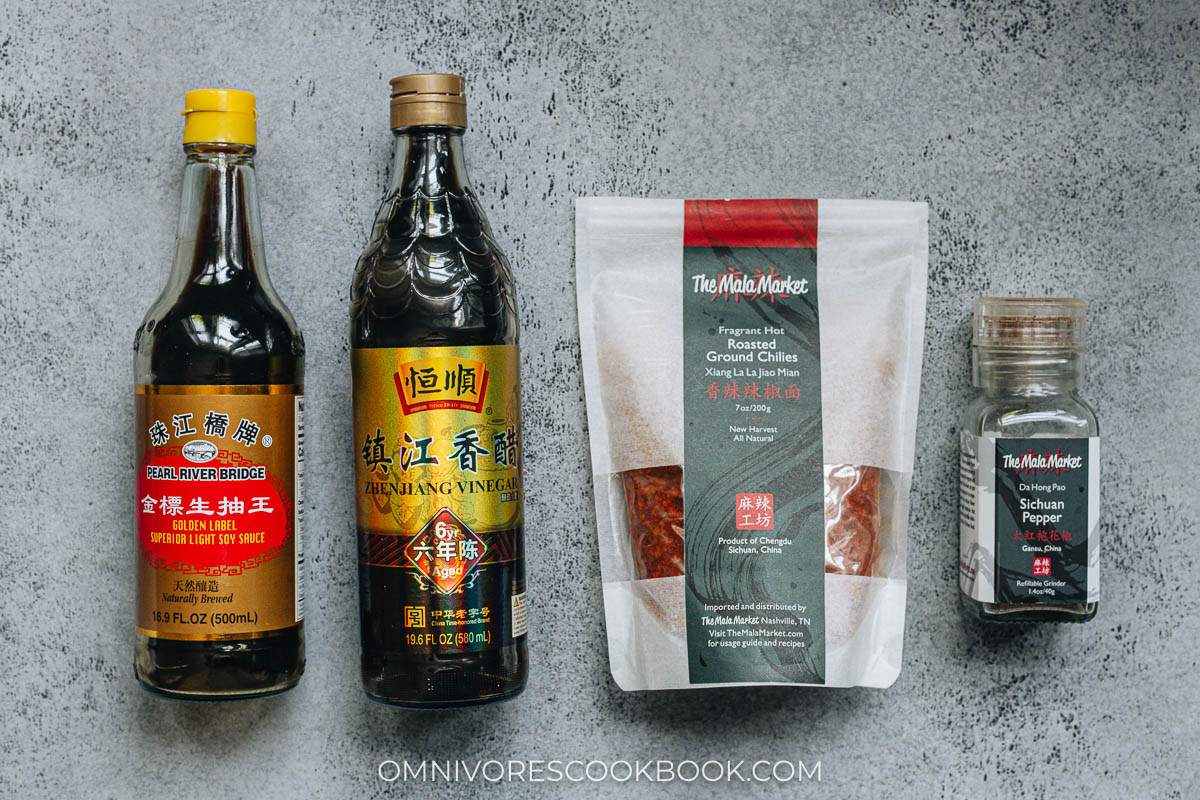
How to make biang biang noodles
Making biang biang noodles requires a few simple steps:
- Make a simple two ingredient tomato sauce
- Blanch baby bok choy (or any veggies you’d like to top on your noodles)
- Boil the noodles
- Mix the sauce base
- Toss the noodles in the sauce
- Spread the spices and aromatics on top of the noodles
- Heat hot oil and pour it over the spices to cook them
- Immediately mix everything together
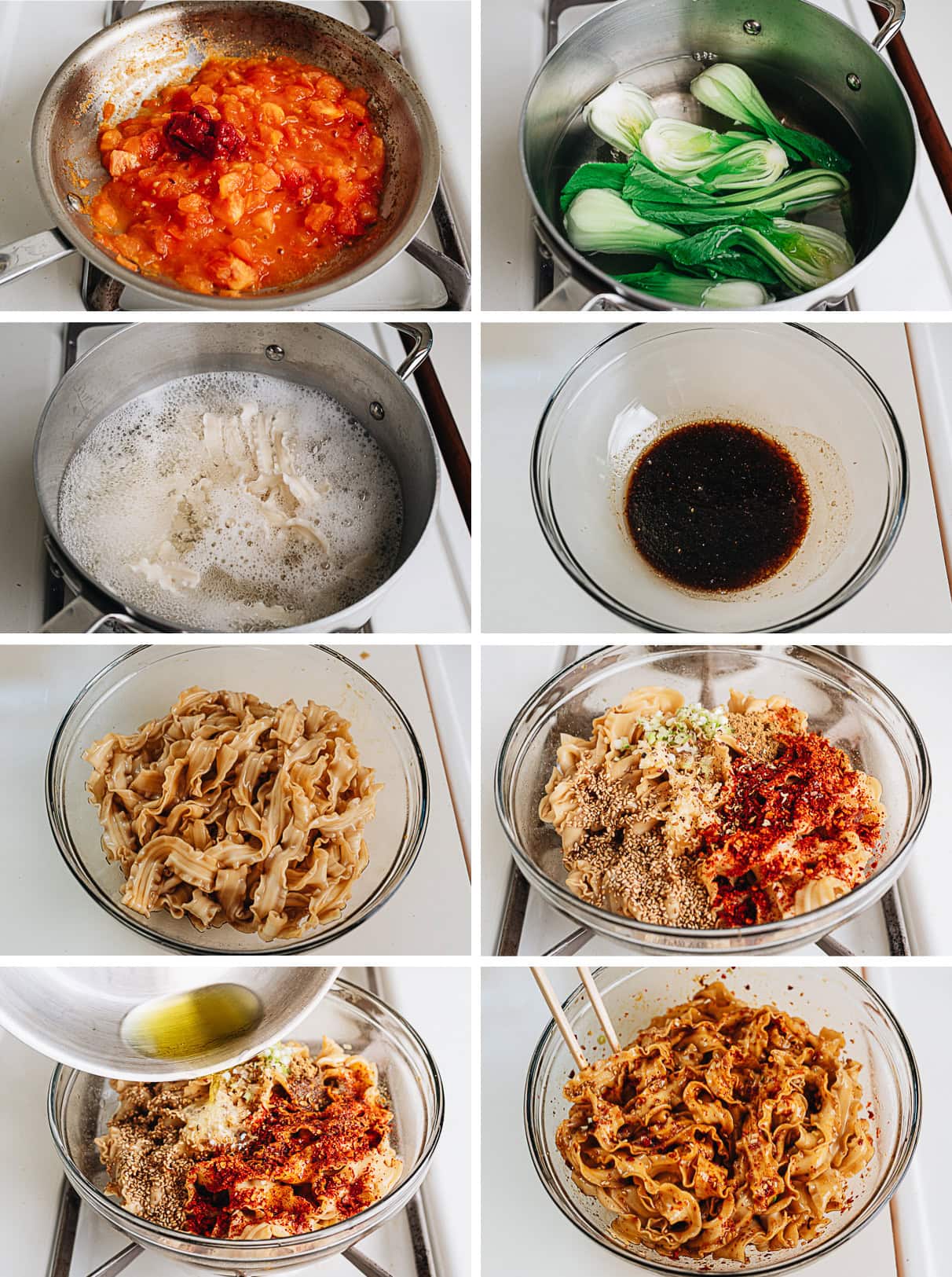
The hot oil will briefly cook the spices and aromatics, making a fresh rich chili oil that is bursting with umami. It’s important to spread the spices evenly, then drizzle the hot oil onto all the spices, as much as possible. The hot oil draws out the fragrance of the ingredients and makes the sauce extra delicious.
I like to add a tomato sauce onto my biang biang noodles. The sour taste and tender texture of the tomato balance out the spiciness of the chili oil, making the dish more rounded with a better mouthfeel. But it’s also OK to skip the tomato sauce, if you prefer to keep the dish very simple.
If you order biang biang noodles in China, the restaurants usually assemble the noodles and the spices individually. In this recipe, I made two servings together in a big bowl so it cuts down on the cooking steps.
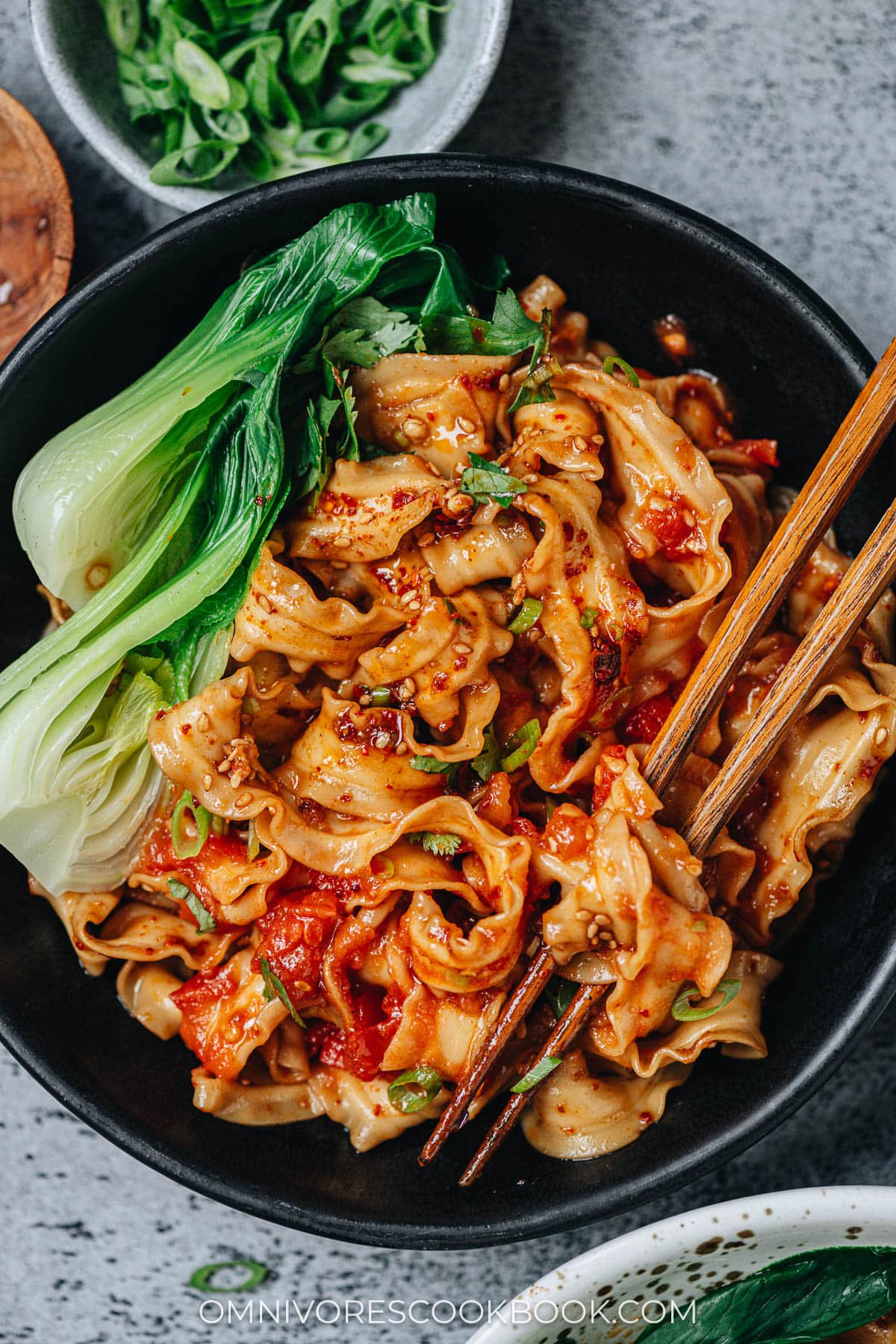
How to serve biang biang noodles
You can serve biang biang noodles as a side dish or a main dish for a light lunch. In China, it is often served as a savory snack that you can enjoy at any time of day.
You can pair biang biang noodles with these dishes for a satisfying meal:
- Cucumber salad
- Xinjiang Lamb Skewers (新疆烤串, chuar)
- Air Fryer Salt and Pepper Chicken
- Chinese Corn Soup with Chicken (鸡蛋玉米羹)
- Chinese Beef Salad
- Pork and Cabbage Stir Fry
- Dried Tofu and Celery Stir Fry (西芹炒香干)
Chinese Cooking Made Easy
Are you new to this website? This free email series is a great place to start. I’ll walk you through a few of my most popular recipes and show you how and why they work. You’ll quickly start to cook better Chinese food in your own kitchen.
Watch video
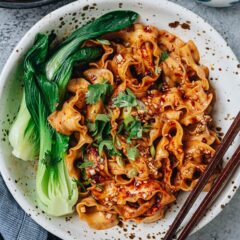
Biang Biang Noodles (Yu Po Mian)
Ingredients
Tomato sauce (optional but recommended)
- 1 tablespoon peanut oil (or vegetable oil)
- 2 tomatoes , diced
- Pinch of salt
- 1 tablespoon tomato paste
Noodle sauce
- 1 tablespoon light soy sauce
- 1 tablespoon Chinkiang vinegar
- 1/4 teaspoon dark soy sauce (optional)
- 1 teaspoon sugar
- 1 teaspoon sesame oil
- 1 green onion , white part minced, green part sliced for garnish
- 3 cloves garlic , grated
- 1 tablespoon Chinese chili flakes
- 1 tablespoon toasted white sesame seeds
- 1/4 teaspoon cumin powder
- 1/4 teaspoon ground Sichuan peppercorn (optional but highly recommended)
- 3 tablespoons peanut oil (or vegetable oil)
Noodles
- 2 bundles (150 g) dried knife shaved noodles (or 400 g fresh wide noodles or hand pulled-noodles)
- 4 heads baby bok choy , tough ends removed and cut into large bite size pieces (*Footnote 1)
- Chopped cilantro for garnish (Optional)
Instructions
Make tomato sauce
- Add 1 tablespoon of oil into a medium-sized skillet and heat over medium heat until hot. Add the tomato and a pinch of salt. Chop and stir the tomatoes until the tomato pieces break down, 4 to 5 minutes. Pour in a small splash of water if the pan becomes too dry. Add the tomato paste. Keep stirring for 1 minute until the tomato paste is evenly mixed. Transfer to a bowl and set aside.
Assemble noodles
- Combine the soy sauce, Chinkiang vinegar, sesame oil and sugar in a large bowl. Stir to mix until the sugar has dissolved.
- Bring a large pot of water to a boil. Blanch the baby bok choy for 2 minutes or so, until tender. Transfer the bok choy to a plate to cool off.
- In the same pot, boil the noodles according to instructions. Once the noodles are done, quickly rinse with running tap water to stop cooking. Then drain thoroughly and transfer to the bowl with the soy sauce mixture. Stir to combine.
- Add the white part of the green onion, garlic, chili flakes, sesame seeds, cumin powder and ground Sichuan peppercorn on top of the noodles.
- Heat the oil in a small saucepan over medium heat until hot. Immediately pour the hot oil over the noodles, covering as much seasoning as possible. Then stir everything together to mix well while the oil is still hot.
- Add the tomato sauce and mix again (if using).
- Garnish with baby bok choy and cilantro. Serve immediately.
Notes
- Other Chinese greens like choy sum, gai lan, and pea shoots all work well. You can also cut up some cucumber and top it on the noodles directly.
Nutrition

Did you make this recipe?
I’d love to hear how it turned out for you! Please take a moment to leave a 5-star rating ⭐️ and share your thoughts in the comments further down the page. It really helps others discover the recipe too.

Andrea Lin
I’ve made this twice now and we love it! The chili oil is so good and you describe the process perfectly; we use it on everything, even mac ‘n cheese. I also made a no-chili version for my kids because they can’t handle la heat but they love the ma of Sichuan peppercorn. I love your approach to cooking. Your meticulous descriptions make it possible for me to get it right on the first try. It’s probably not an overstatement to say my husband loves me more for the recipes I have made off of this site!
Chris
Thanks for this wonderful recipe. I made it last night, just as written. It was so delicious! I loved that the chili oil and seasoned soy sauce were separate so you could mix according to taste…I think I could eat that chili oil on ANYTHING…and I probably will! In soup tonight I think…😊
Germaine
Hi Maggie, what’s the difference between this chilli oil and this (https://omnivorescookbook.com/how-to-make-chili-oil/)? Are they interchangeable? Thanks! PS I made your dan dan mian yesterday – so good!
Maggie
Hi Germaine, the two chili oil recipes use a slightly different approach but they are interchangeable. The one listed here is actually more complicated (learned it from another website) but the “How to Make Chili Oil” recipe is my default recipe of all time.
Glad you like my dan dan noodle recipe! Hope you enjoy this one as well 🙂
Jade
Hello, this looks delicious! For the soy sauce, is it 3/4 cup? The unit seems to be missing from the recipe. Thanks!
Maggie
Sorry about that! Yes, it is 3/4 cup. I just updated the recipe so it should look good now. Happy cooking!
Victor
I believe this character has a bit less strokes. Only 55. I counted number of stokes many times and never come to 58.
Jan
Super good. I replaced the tomato sauce with ketchup for my kids and they loved it 🙂
David
This is my first time attempting any sort of Chinese food from scratch. I used your sauce recipe (w/o the optional tomato) as I was originally just looking for a spicy Szechuan heavy sauce, similar to some I’ve had in the past, to use with some similar hand made egg noodles I was making. Delicious! The sauce was so good, I feel like a (semi) pro now!
I will definitely try your noodle recipe soon as I’d like to try this dish again without egg taste.
Helen
Maggie! What a gift you have given us with this amazing recipe!! I live in Canada and these noodles remind me of Xi’an Famous – my favorite NYC noodle joint. When I cook this sauce, I always add 1 package of Filipino Magic Sarap in my wok while sautéing my protein/veggies. Amazing kick to your delicious recipe. ?
Maggie
I’m so glad you like the recipe Helen! I think most people were scared by the long ingredient list…
I’ve never tried Filipino Magic Sarap but it sounds so yummy! I have yet been to Xi’an Famous. Will definitely add it onto my to-eat list when I travel to New York the next time.
Hope you have a great week ahead and happy cooking 🙂
Ting
Hi can I use any red chilli powder?
Thanks!
Maggie
Hi Ting, yes you can. Just note that depends on the spiciness of the chili powder, the hot oil might come out quite spicy. In that case, use less in your noodles otherwise the dish might end up too hot.
Happy cooking and hope your dish will turn out great 🙂
Karen Fukui-Miner
Hi Maggie, thanks for sharing your recipe. At first, the recipe looked daunting, but I made the chili oil one day, a few days later made the seasoned soy sauce, then the noodles, meat, vegetables (cabbage and bean sprouts) a few days later. The noodles were delicious, just like the noodles I had at a restaurant in Seattle. The noodles take a little planning but are well worth the effort. Everyone who has tried the noodles have loved them!
Maggie
Hi Karen, I’m so thrilled to hear you made this dish! When I posted the recipe, I thought “who’s gonna make it?”. It looks so long! Just like you mentioned, we usually cook the sauces separately in large batches, so it won’t be too time consuming when you put the noodle dish together. Now since you have the seasoned soy sauce and chili oil, you can make many dishes or use them to make stir fry. One sauce I love: add the seasoned soy sauce and chili oil into peanut butter, then you get the best peanut sauce. It’s so good serving with chicken.
Thanks for taking time to leave a comment! Have a great week ahead 🙂
Alberto
Ottima ricetta!
Mary
Hi Maggie, I would like to make this dish this weekend, could you please clarify something – in the cooking notes you mention curry powder but this is not mentioned in the ingredient list. Were you referring to the cumin/coriander powder?
I made your hand stretched noodles last night, they were fantastic. Thanks for your recipes!
Maggie
Hi Mary, thank you for letting me know this! I just updated the recipe and deleted curry powder from the instructions. A pinch of curry powder can be added into the chili oil, as a hidden flavor. But since it won’t make a huge difference, I decided it’s totally OK to skip it.
I’m so glad to hear you tried out my recipe and liked it! I like that handmade noodles recipe a lot too. Hope this dish will turn out great too! Happy cooking 🙂
Kathleen | Hapa Nom Nom
I think some of the very best foods come from simple means. I have somewhat of an addiction to spicy noodle dishes and this looks like it would totally satisfy my cravings – definitely a foodgasm!
Bam’s Kitchen
3 amazing sauces and one very delicious dish! It really is all about the sauces and the texture of the noodles that makes this dish so delicious. Great instructions and beautiful photos! Now you know why it is so difficult for me to learn Chinese Characters, 58 strokes, oh my goodness. I hope that one is not on the boys vocabulary list or I am throwing in the towel! Pinning and sharing my friend!
Nagi@RecipeTinEats
The care in which you take and the extent of helpful information you provide constantly blows my mind. This looks incredible Maggie. I LOVE spicy and big flavours and this just ticks all my boxes! Pinning!
mira
That character! Love these chunky noodles Maggie! Great flavors!
Becky Winkler (A Calculated Whisk)
These noodles look so amazing, Maggie! I am a huge fan of big fat noodles so this is pretty much my dream meal. Love your photos!
Helen @ Scrummy Lane
58 strokes in 1 character? That’s fascinating, Maggie!
As for the noodles, well, I’ve been eyeing them up already on social media … they look just incredible. So simple (as usual) and tasty (as usual).
You are my real Chinese food guru, Maggie!
THE HUNGRY MUM
Loving the look of these chunky noodles. Love the suggestion that their popularity is due to the intricate character 🙂
nicole (thespicetrain.com)
P.S.: And yes, that Chinese character is insane all right! 🙂
nicole (thespicetrain.com)
These noodles look so delicious! I always love your detailed descriptions and history of the dishes, it’s so interesting!